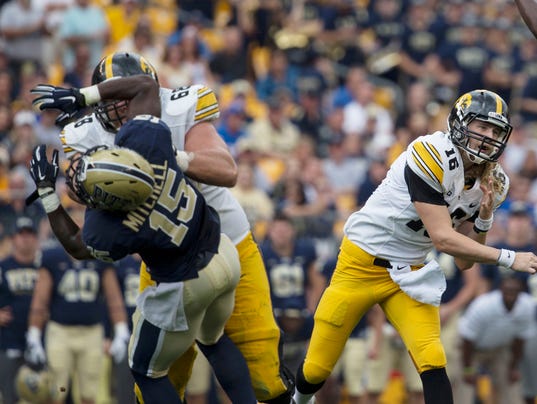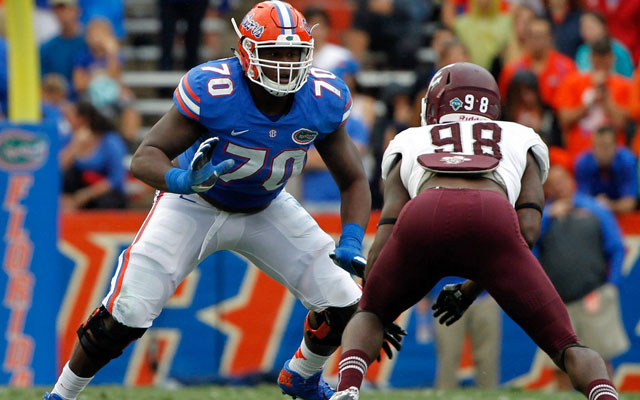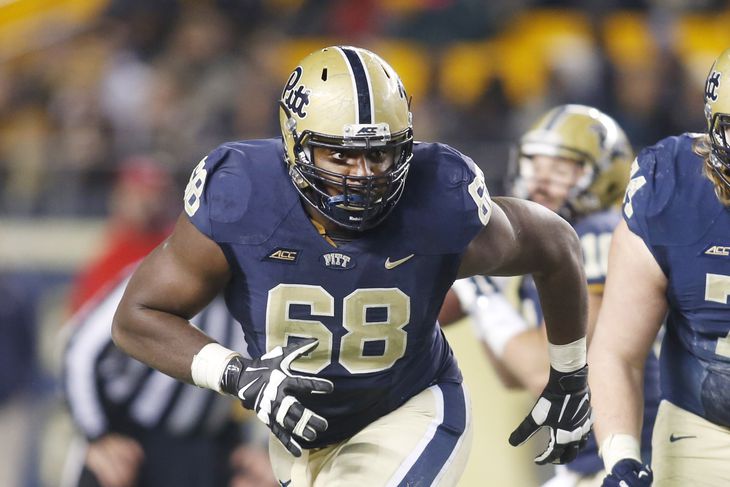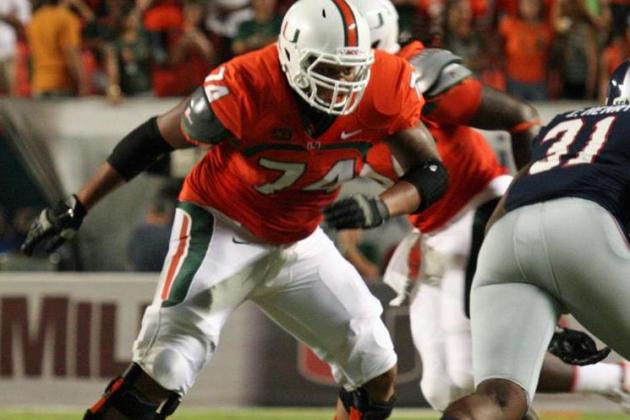After spending last week breaking
down the two most difficult positions in the draft, I thought I’d return to
something more in my wheelhouse. This year lacks premier talents on the
offensive line, but there are a few quality
starters to be found in the first couple rounds. There has been a trend in
recent years towards smaller, more athletic linemen, and a lot of these players
fit that mold, athletes with high upside and little polish. Most of those
players are farther down in my rankings, as I prefer linemen who I can count on
to be reliable starters and safe picks.
Andrus Peat – Stanford

Peat is a capable, if
unspectacular run blocker. He doesn’t create much movement down the field, but
he can be a mauler when asked to pull off a simple down block. His excellent
feet allow him to easily seal a defender off, and his strength prevents him from
being knocked backwards. He could probably stand to play a little lower and to
use his hands better, but he does what is asked of him in the running game.
Where he really shines is as a
pass blocker, specifically in his initial step. The first step is the most
important part of playing offensive tackle, a lateral drop to get into position
to cut an edge rusher off from the quarterback. For many tackles this is a very
mechanical motion, practiced to the point of inflexibility. This is not the
case with Peat. He adjusts his drop depending on the alignment in front of him,
dropping further when there is someone out wide to cut off edge rushes. He does
a fantastic job getting deep while still keeping his balance on his front foot,
anchoring himself to absorb potential inside moves. His initial step is the
best of any lineman in the draft, and it makes him almost impossible to beat
off the snap.
If there are flaws to pick in
Peat’s pass protection abilities, they’re to be found at the back end of his
drop. He plays a bit too upright, and he prefers to catch rushers rather than
attacking. Both of these leave him open to a bull rush, though he wasn’t
particularly vulnerable to that in college. His bigger issue was with speed, a
result of his feet sometimes coming to a stop at the top of his drop. His
recovery skills are impressive, and in most cases he was able to get himself going again before this became an issue. But against top edge rushers, the sort he
will face on a weekly basis in the NFL, he was beaten around the corner a bit
more than you would care for from a starting left tackle.
Peat’s upside is intriguing, even if he will probably never be a Pro Bowl left tackle. But he is one of
the safest picks in the draft, at a position where simple competence is worth
so much. He will likely be available as a steal sometime in the second half of
the first round, and I think it would be only a minor reach if a team grabbed
him somewhere in the top ten.
La’el Collins – LSU

I am considering Collins as a
tackle for this exercise, since that is the ideal future position for him. He
has excellent feet as a pass blocker, taking an aggressive initial step towards
the rusher and engaging a safe distance away from the quarterback. He doesn’t
always keep his feet moving after initial contact, but when he does he can move
laterally to absorb any secondary pass rush moves. His bulk allows him to
anchor extremely well, preventing rushers from driving him backwards and
cutting off many inside moves.
Collins is less polished
technically in the running game, but he has all the tools to be one of the best
in the league. He gets excellent position with his hands, leveraging beneath a
defender’s shoulders and lifting him up so he can drive him backwards. His
hips are very mobile, allowing him to swing around after engagement to seal the
defender off. At times he can be exposed by leaning too far forward and getting
off balance, but most of the time his strong hands keep him engaged up to and
through the whistle. No one in this class finishes blocks like Collins, and it
is a regular occurrence to see him throw his man onto his back as the play
winds down.
The biggest concern for Collins
as a tackle is his lack of length. He is only 6’4” tall, and though his long
arms make up for some of this shortfall, he will still have trouble containing
the fastest rushers around the edge. Physically he looks more like a guard, and
if he finds himself forced to move inside in the NFL it won’t be a huge loss.
He’ll need to become stronger if that is his long term role, but I trust that
an NFL training staff will be able to manage this. Collins’s versatility makes
him one of the safest picks in the draft. Even if he fails as a tackle, he will
still be able to contribute as an above average guard for years to come.
Brandon Scherff – Iowa

Scherff is the prototypical
mauler on the inside, a big, physical guard who will overwhelm defenders and
shove them out of the play. His strength in the weight room is the stuff of
legends, and it translates to the field. When he can get a defender squared up,
there is very little that defender can do. He strikes with precision and
strength on his punches, and his hands are like black holes. Once a defender is
sucked in, there is no hope of escape.
As good as his hands are,
Scherff’s feet are every bit as bad. He doesn’t turn his hips when he engages
with a block, giving the defender lanes to fall on either side in order to make
tackles. Scherff is slow reacting when he has to move from one block to
another, and he is hopeless when he tries to move sideways. These
limitations absolutely killed him as a tackle, and they will present only a
smaller problem once he’s moved inside. His lack of agility will always hold
him back in pass protection, and whoever drafts him will have to hope that
repetitive technique work will at least make him serviceable.
Currently most mock drafts have
Scherff projected to go in the top ten. That is a mistake, reaching for
a player with limited upside at a position of minimal value. This year’s guard
class is weak, and Scherff is definitely the best guard in the draft. But
picking him anywhere in the top twenty will be a serious reach. If a team is
set at both tackle positions and desperately needs a guard only, I could
understand taking Scherff. But for anyone else, I think they would be better
off investing in Collins’s versatility.
DJ Humphries – Florida

When he’s on, Humphries shows the
ability to be the best tackle in the draft. He is overpowering in the run game,
collapsing the defense and driving his man several yards past the line of
scrimmage. His initial punch is powerful enough to bend defenders over
backwards, and he moves with a low center of gravity that allows him to stay
balanced and avoid being knocked backwards. His feet are phenomenally quick,
and even when he makes a mistake he can usually recover before it becomes a
problem.
The issue with Humphries is the
occasional disappearance of everything I praised above. His punch is powerful, but
it is also inaccurate and occasionally forgotten. He has a habit of catching
pass rushers in his chest, and his hands will often shoot harmlessly over a
defender’s shoulders. His feet can recover quickly, but he is sometimes slow in
reacting, staying moving in one direction while the defender goes the other. It
doesn’t help that he is slow off the ball and gives ground too easily,
minimizing the room he has for error.
These issues pop up frequently in
pass protection, making it a risky prospect to draft him with the intention of
installing him as a left tackle. A year or two down the road, when he irons out
the flaws in his game, he could be the best lineman to come out of this draft.
But the risk he carries makes him unworthy of anything more than a late first
round pick.
TJ Clemmings – Pittsburgh

As you can probably guess from my
description of him as a right tackle, Clemmings is better as a run blocker than
a pass blocker. He has potential in pass sets, but he can still be a bit
mechanical in his drops and doesn’t always keep his feet moving once he makes
contact with the defender. When he keeps good footwork and balance, he is
almost impossible to beat. His arms are incredibly long, and he is quick enough
that it is difficult to beat him around the edge. He will sometimes overextend
and leave himself vulnerable to secondary moves, but more experience will clean
up these shortcomings.
As a run blocker, Clemmings is as
impressive as anyone in the draft. He engages with his hands and creates
fantastic separation with the defender, giving him the ability to turn them
with just his upper body and drive them back away from the line. He could stand
to get better at turning his feet to seal his man away from the play, and he is
sometimes a bit too slow out of his stance.
There is no one in this class
better at moving in open space and getting to the second level. Clemmings is a
smooth athlete, with a ceiling as a Pro Bowl player and a floor as an average
guard. It was very close between him and Humphries, and ultimately the only
thing that separated them was polish. Clemmings probably has slightly higher
upside, but he has a lot more work to do if he’s going to reach his potential.
Jake Fisher – Oregon

Fisher has excellent strength to
go along with his speed, particularly in the upper body. His initial punch is
devastating, knocking defenders backwards and giving him the ability to create
significant movement in the running game. He has the ability to finish his
blocks just with his upper body, twisting and throwing defenders to the ground
to get them out of the play. He is a better run blocker than most of the
offensive tackles in the draft because of his ability to overwhelm smaller defensive
players.
If he is going to succeed in the
NFL, he will need to make major improvements with his footwork. His hips are
inflexible, and he sometimes stays too square to the line, giving up rushing
lanes that shouldn’t be available. He has trouble sealing a defender off once
he’s engaged, and he can’t move quickly enough side to side to stay in front of
quicker pass rushers. Stronger hands could solve some of these problems, but
after his initial punch he really doesn’t show the ability to control the
player across from him.
I don’t think Fisher is ready to
start right away, and if he is it would only be at right tackle. Long term he
might be able to pack mass onto his frame and move into guard, but I think his
length and his athletic ability are too inviting to dismiss him as a tackle.
He’s a project probably best suited as a second round pick, though it wouldn’t
be ridiculous to see him sneak into the first.
Ereck Flowers – Miami

He is also desperately lost as a
pass blocker. He takes a big, aggressive kickstep which, combined with his long
arms, allows him to cut off most outside rushes. But once he’s made this
initial step, he doesn’t have the footspeed to react back inside. He rarely
engages with his hands, and he gets shoved around with far more ease than you
would ever expect to see from a 329 pound man. At the heart of all these
troubles is a fundamental issue with balance. He is almost always standing too
upright or leaning too far forward, robbing himself of the ability to shift
laterally or anchor into the ground.
The talent and the size are
there, and I guess I can see why some people consider him among the top tackles
in the class. But once he steps out of the trainer’s room and onto the football
field, he doesn’t measure up to the other premier linemen. I see him as a
second round prospect who will likely go in the first to a team that has
convinced themselves that they can clean up his issues.
Cedric Ogbuehi – Texas A&M

Let’s start with the good.
Ogbuehi has excellent feet, quick and constantly moving beneath him. He relies
on short choppy steps that prevent him from becoming overextended or leaning
too far one direction. This gives him the ability to react
instantaneously to an opposing player’s moves, and it shows up as excellent
recovery ability when he is beaten. This is very fortunate, since his technique
leads to him being beaten quite often.
Ogbuehi prefers to drop straight
back rather than attacking towards the outside. This allows him to absorb
inside moves without much trouble, but it also limits his ability to cut off
speed rushers from reaching the quarterback. He might be able to make this work
if he used his arms to create separation, but on most plays I’m not certain
Ogbuehi realizes he has arms. He prefers to catch pass rushers in his chest,
surrendering ground and control on a consistent basis. When he does use his
arms they end up very wide, wrapping defenders around the shoulders in clear
holds that should be called several times a game.
On the whole, Ogbuehi is an ugly
player who needs to completely overhaul his technique before he can play in the
NFL. Athleticism and footwork will only get him so far, and if a team tries to
rush him into the starting lineup they will get their quarterback killed.
Ogbuehi has fallen all the way to the second round, but I think he needs to go
even further. I’d probably be willing to take a flyer on upside in the third
round, but anything before that is simply laughable.
No comments:
Post a Comment